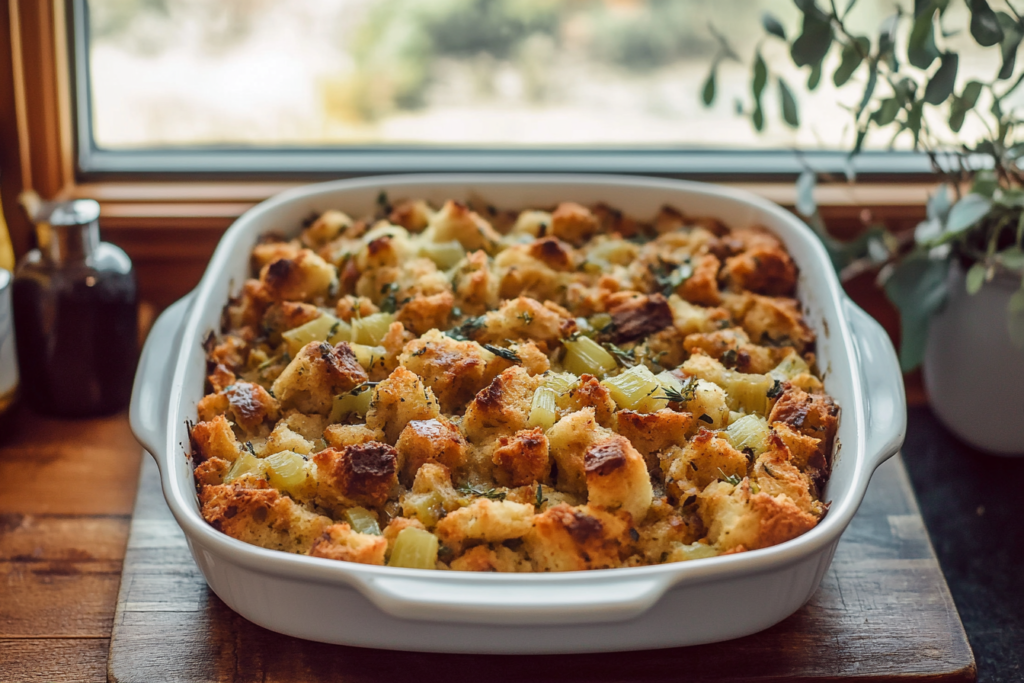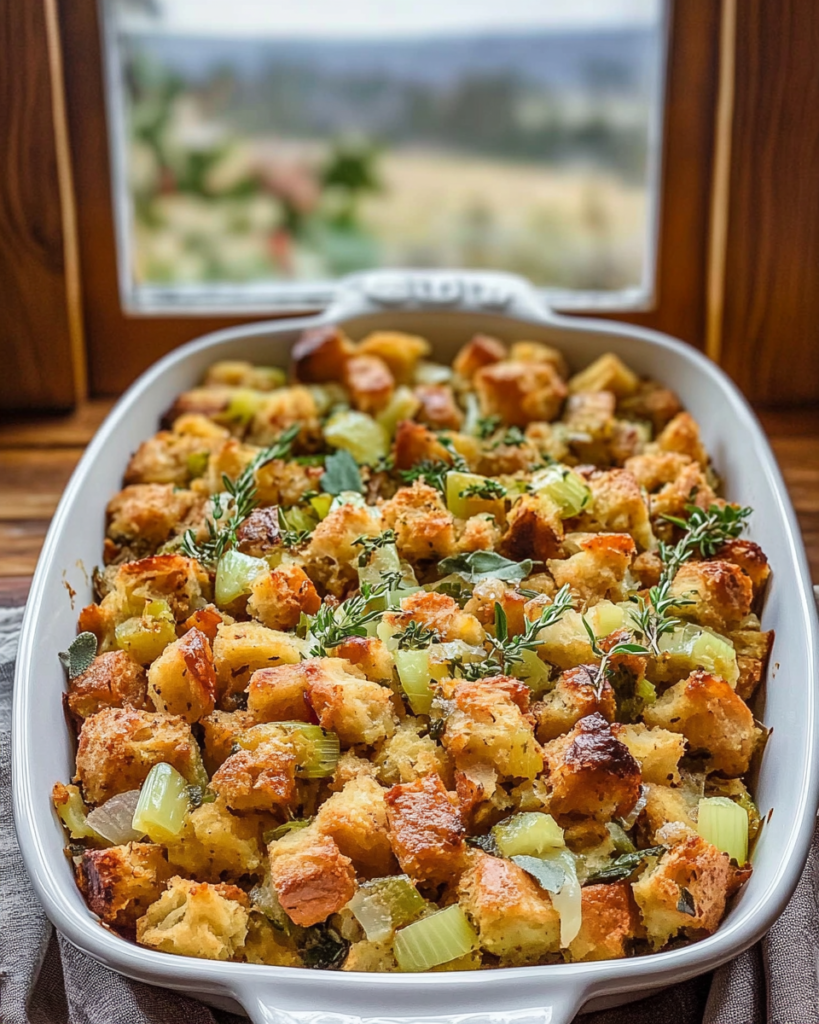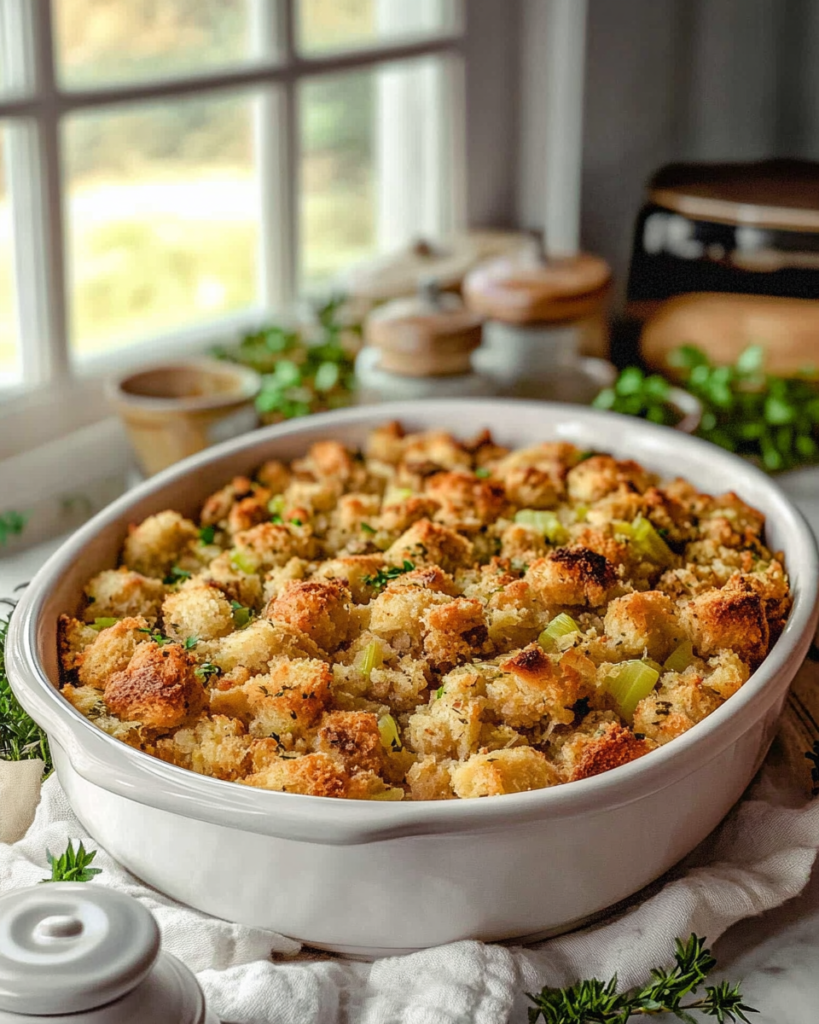
Stuffing is the heart of a holiday meal—warm, savory, and nostalgic. Whether served alongside roast chicken, turkey, or as a stand-alone side, it’s a dish that carries deep-rooted tradition. In American households, homemade stuffing recipe often symbolizes family, celebration, and comfort.
Historically, homemade stuffing recipe was used to fill meats before roasting, but today it’s just as often baked in a dish of its own. This homemade version brings together hearty bread cubes, sautéed veggies, herbs like sage and thyme, and a rich, buttery broth. The result? A dish that’s crisp on top, tender inside, and packed with flavor.
Whether you’re hosting Thanksgiving, Christmas, or just craving comfort food, this stuffing recipe delivers every time. It’s simple, satisfying, and endlessly adaptable—perfect for making ahead or serving fresh from the oven. Let’s bring tradition to the table with a modern, delicious twist.
Why You’ll Love This homemade stuffing recipe
This homemade stuffing isn’t just good—it’s unforgettable. Here’s why it deserves a spot at your festive table:
- Bold, Cozy Flavors: Onions, celery, garlic, and herbs sautéed in butter create a base that’s rich and comforting. Every bite tastes like the holidays.
- Perfect Texture: Crisp on the outside, moist and fluffy on the inside—this stuffing strikes the ideal balance without turning soggy or dry.
- No Pork or Alcohol: This version skips pork-based ingredients and replaces any alcoholic liquids with flavorful, family-friendly broth. Everyone can enjoy it.
- Customizable: Want to add mushrooms, apples, or dried cranberries? Go for it. This recipe is your canvas.
- Make-Ahead Friendly: Prepare it in advance and pop it in the oven just before mealtime. It reheats beautifully and saves you last-minute stress.
- Family Favorite: Kid-approved and grandma-approved—this dish wins hearts across generations.
With flavor, ease, and flexibility on its side, this stuffing is ready to become a new tradition in your kitchen.
What You’ll Need
Making the perfect homemade stuffing starts with quality ingredients. Each one plays a specific role—adding flavor, texture, or moisture to the dish. Below is everything you’ll need to make a classic, savory homemade stuffing recipe that will win over any crowd.
1. Bread (10 cups, cubed and dried)
Choose a hearty bread like French bread, sourdough, or Italian loaf. Cube it into ¾-inch pieces and dry it out overnight or toast it in the oven. Dry bread absorbs flavors better, giving you stuffing that’s moist but never soggy.
2. Unsalted Butter (½ cup or 1 stick)
Butter adds richness and helps soften the vegetables. It also gives the stuffing that traditional, melt-in-your-mouth flavor.
3. Onion (1 large, finely diced)
Yellow or white onion adds a sweet, savory base. Make sure to chop it small so it cooks evenly and blends well into the stuffing.
4. Celery (4 stalks, diced)
Celery adds crunch and a fresh, slightly peppery note. It’s essential for that classic holiday stuffing flavor.
5. Garlic (2 cloves, minced)
A little garlic goes a long way in enhancing the overall depth of flavor without overpowering the herbs.
6. Fresh Herbs
- Fresh Sage (1 tablespoon, minced)
- Fresh Thyme (1 tablespoon, minced)
- Fresh Parsley (2 tablespoons, chopped)
Herbs bring brightness and aroma. You can use dried herbs if fresh aren’t available—just reduce the quantity by one-third.
7. Salt (1½ teaspoons) + Pepper (½ teaspoon)
Seasoning is key. Add more to taste after baking, if necessary.
8. Vegetable Broth (2½ cups)
Choose a high-quality, low-sodium broth. It keeps the stuffing moist and ensures every bite is flavorful. This non-alcoholic alternative to meat-based broths makes the dish vegetarian-friendly.
9. Eggs (2 large, beaten)
Eggs help bind everything together, so the stuffing holds its shape when served. They also enrich the texture.
Optional Add-ins (½ cup to 1 cup each)
- Diced mushrooms
- Chopped apples
- Toasted pecans or walnuts
- Dried cranberries or raisins
These can add sweetness, crunch, or extra savoriness depending on your preferences.
With these ingredients, you’re ready to create a stuffing that’s fragrant, hearty, and worthy of any holiday meal.

How to Make homemade stuffing recipe
This stuffing recipe is easy to follow and delivers reliable results every time. Here’s a step-by-step breakdown to guide you through the process, from prepping your ingredients to pulling a golden, fragrant dish from the oven.
Step 1: Prepare the Bread (10 cups total)
If you haven’t already dried your bread, cube it and spread it on a baking sheet. Bake at 275°F (135°C) for about 40 minutes, tossing halfway through, until the cubes are dry but not browned. Set aside to cool.
Step 2: Cook the Vegetables
In a large skillet, melt ½ cup (1 stick) of unsalted butter over medium heat. Add the diced onion (1 large), celery (4 stalks), and minced garlic (2 cloves). Sauté for 8–10 minutes until vegetables are soft and fragrant but not browned.
Step 3: Add the Herbs
Stir in 1 tablespoon each of fresh chopped sage and thyme, and 2 tablespoons of parsley. Let the herbs cook for 1–2 minutes to release their oils and enhance their flavor.
Step 4: Combine the Bread and Veggies
Transfer your toasted bread cubes to a large mixing bowl. Pour the cooked vegetable and herb mixture over the bread and toss to combine.
Step 5: Add Broth and Eggs
In a separate bowl, whisk together 2½ cups of vegetable broth and 2 large beaten eggs. Slowly pour this over the bread mixture while gently tossing, making sure the bread absorbs the liquid evenly.
Step 6: Add Optional Ingredients (if using)
Fold in any add-ins like chopped apples, cranberries, or nuts. This is your chance to personalize the stuffing to your taste.
Step 7: Transfer to Baking Dish
Grease a 9×13-inch baking dish and pour the stuffing mixture in. Spread it evenly, pressing down lightly with a spatula to help it set.
Step 8: Bake
Cover the dish with foil and bake at 350°F (175°C) for 30 minutes. Remove the foil and continue baking for 20–25 minutes more, or until the top is golden brown and slightly crisp.
Step 9: Serve
Let the stuffing cool for 5–10 minutes before serving. Garnish with extra parsley for a fresh finish.
With these instructions, you’ll create stuffing that’s soft inside, golden outside, and bursting with flavor in every bite.
You Must Know
Before you dive into making stuffing, there are a few key things that can make or break your results:
- Bread Must Be Dry: Fresh bread will turn your stuffing mushy. Use day-old bread or toast it in the oven. Dry bread soaks up the broth and flavor without getting soggy.
- Chop Ingredients Evenly: Dice your onion, celery, and any add-ins into small, uniform pieces. This helps them cook evenly and blend smoothly into the dish.
- Don’t Overmix: When combining the bread, broth, and eggs, fold everything gently. Overmixing will break the bread and turn the stuffing dense.
- Let It Rest Before Baking: After mixing, let the stuffing sit for 10–15 minutes. This gives the bread time to fully absorb the liquid, which improves texture.
- Check Seasoning: Broths can vary in saltiness. Taste the mix before baking and adjust with salt and pepper as needed.
These quick tips will help you avoid common mistakes and ensure your stuffing turns out just right—tender, flavorful, and never mushy.

Perfecting the Cooking Process
Cooking stuffing isn’t complicated, but nailing the timing and texture takes just a little care:
- Cover First, Then Uncover: Start with foil to trap moisture. Uncover halfway through to let the top get golden and slightly crispy.
- Use the Right Dish: A 9×13-inch dish gives the stuffing plenty of room to cook evenly. If it’s too deep, the center can stay wet while the top browns.
- Don’t Overbake: Stuffing should be moist inside. Check around the 45-minute mark. If it’s dry, drizzle with a bit more warm broth and cover again.
- Let It Cool Before Serving: Stuffing sets as it cools slightly. Let it rest for 5–10 minutes so it holds together better when served.
Perfect cooking is all about balance—moist inside, crisp on top, and full of flavor. Follow these tips, and your stuffing will be the side dish everyone remembers.
Add Your Touch
One of the best things about homemade stuffing is how easy it is to personalize. You can stick to the classic recipe or add your own twist to match your family’s tastes or dietary needs. Here are some simple ways to make it your own:
- Flavor Boosters: Add a dash of garlic powder, onion powder, or smoked paprika to give the stuffing more depth. A sprinkle of parmesan or cheddar can also add a savory bite (just avoid salty cheeses if your broth is already seasoned).
- Fruit and Nuts: For a hint of sweetness, toss in chopped apples, dried cranberries, raisins, or apricots. Want crunch? Toasted pecans or walnuts add texture and a nutty flavor.
- Veggie Additions: Sautéed mushrooms, diced carrots, or even small cubes of roasted butternut squash can elevate the dish. These add both nutrition and vibrant color.
- Herb Variations: Feel free to mix in rosemary or marjoram with the sage and thyme. Fresh herbs really bring out holiday warmth, but dried herbs work too—just use less.
- Bread Swaps: Use cornbread for a Southern twist, or multigrain for added nuttiness. Even gluten-free bread works if properly dried out first.
Customizing your stuffing makes it feel personal and fresh every time you make it. It’s a blank canvas for creativity and tradition combined.
Storing & Reheating
Leftover stuffing stores well and reheats beautifully, which makes it ideal for holiday meal prep or the next-day feast.
Pair it with this flavorful side for a complete meal.
To Store:
- Refrigerate: Let the stuffing cool to room temperature, then transfer it to an airtight container. It will keep well in the fridge for up to 4 days.
- Freeze: For longer storage, place the cooled stuffing in freezer-safe bags or containers. Label it with the date and use within 2 months for best flavor.
To Reheat:
- Oven (Best Method): Preheat to 350°F. Spread stuffing in a baking dish, cover with foil, and heat for 20–25 minutes. For a crispy top, uncover during the last 5 minutes.
- Microwave: For quick servings, microwave a portion in a covered dish for 1–2 minutes. Add a spoonful of broth if it seems dry.
Tips for Moisture:
Always add a splash of broth before reheating to refresh the texture and keep it from drying out. Avoid overcooking, as that can turn the stuffing gummy or rubbery.
Whether you’re preparing ahead or enjoying leftovers, proper storage and reheating will keep your stuffing just as satisfying the second time around.
Add more variety to your menu with this easy favorite.

Chef’s Helpful Tips for homemade stuffing recipe
Want perfect stuffing every time? These quick tips will take your dish to the next level:
- Use Dry Bread: Day-old or oven-toasted bread gives the best texture—moist inside, crisp outside.
- Sauté Slowly: Cook onions and celery on medium-low heat to bring out their sweetness.
- Warm the Broth: It blends better and prevents the eggs from scrambling.
- Rest Before Baking: Letting the mix sit for 10–15 minutes helps bread absorb flavor evenly.
- Cover, Then Uncover: Bake with foil first to keep it moist, then uncover to crisp the top.
- Make It Ahead: Mix everything the day before, refrigerate, and bake fresh the next day.
These simple tips make a big difference—your stuffing will be flavorful, balanced, and holiday-table ready.
FAQ
Can I make stuffing ahead of time?
Yes! Assemble it the day before, refrigerate, and bake when ready.
Can I make it vegetarian or vegan?
Absolutely—use vegetable broth, olive oil, and skip the eggs or use flax egg as a binder.
Looking for another comforting classic? Try this one.
Why is my stuffing dry or soggy?
Dry? Add broth and cover. Soggy? Bake uncovered a bit longer. Use dry bread for best results.
Can I freeze stuffing?
Yes. Cool it completely, freeze in portions, and reheat in the oven after thawing.
Should I cook it in the turkey?
It’s safer and more reliable to bake stuffing separately—moist and delicious every time.
Conclusion
Stuffing is more than just a side dish—it’s the heart of a holiday meal, bringing warmth, flavor, and comfort to the table. Whether you’re making it for a festive gathering or a simple family dinner, this homemade recipe offers everything you need: savory herbs, perfectly seasoned vegetables, and tender, golden bread.
With the right bread, a few pantry staples, and thoughtful tips, anyone can master stuffing. You now know how to make it ahead, adjust the texture, store leftovers, and even customize it with your favorite add-ins. No pork or alcohol needed—just good, honest ingredients.
As you serve this at your next celebration, expect compliments and empty plates. It’s a dish people come back for—soft in the middle, crisp on the edges, and full of cozy holiday flavor. Keep it classic or make it your own—the joy is in every bite.
Here’s to making stuffing the star of your meal!

How to Make the Best Homemade Stuffing Recipe from Scratch
Description
This classic homemade stuffing is a savory blend of toasted bread, sautéed vegetables, and fresh herbs. It’s easy to make, comforting, and perfect for any festive meal.
Ingredients
8 cups cubed day-old bread
1 cup diced onion
1 cup diced celery
4 tbsp unsalted butter
2 cups vegetable broth, warmed
2 large eggs, beaten
1 tsp dried sage
1 tsp dried thyme
Salt and pepper, to taste
Instructions
Preheat oven to 350°F (175°C).
Toast bread cubes until lightly golden; set aside.
In a skillet, melt butter and sauté onion and celery until soft.
In a large bowl, combine bread, sautéed veggies, herbs, salt, and pepper.
Whisk broth and eggs together; pour over bread mixture and stir gently.
Transfer to a greased baking dish and cover with foil.
Bake for 30 minutes, remove foil, and bake an additional 15 minutes until golden on top.
Notes
- Use dry bread for the best texture.
Feel free to swap vegetable broth for chicken broth if preferred.
Add dried cranberries or toasted nuts for extra flavor.
